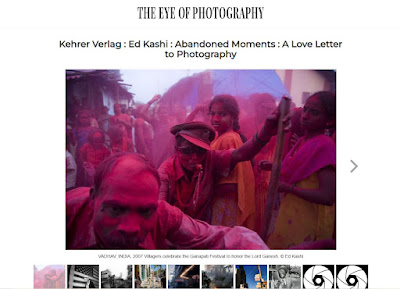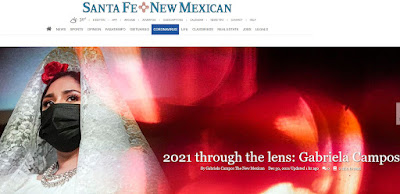Tuesday, January 18, 2022
Ed Kashi : Abandoned Moments : A Love Letter to Photography
Sunday, January 16, 2022
PHOTOGRAPHER STEVE SCHAPIRO DIES AT 87
January 16, 2022
Prolific photographer Steve Schapiro covered major historical events and captured seminal moments of the American Civil Rights Movement
Santa Fe, NM--Steve Schapiro died peacefully on January 15 surrounded by his wife, Maura Smith, and son, Theophilus Donoghue in Chicago, Illinois after battling pancreatic cancer. He was 87.
Steve Schapiro discovered photography at the age of nine at summer camp. Excited by the camera’s potential, Schapiro spent the next decades prowling the streets of his native New York City trying to emulate the work of French photographer Henri Cartier Bresson, whom he greatly admired. His first formal education in photography came when he studied under the photojournalist W. Eugene Smith. Smith’s influence on Schapiro was far-reaching. He taught him the technical skills he needed to succeed as a photographer but also informed his personal outlook and worldview. Schapiro’s lifelong interest in social documentary and his consistently empathetic portrayal of his subjects is an outgrowth of his days spent with Smith and the development of a concerned humanistic approach to photography.
Beginning in 1961, Schapiro worked as a freelance photojournalist. His photographs appeared internationally in the pages and on the covers of magazines, including Life, Look, Time, Newsweek, Rolling Stone, Vanity Fair, Sports Illustrated, People and Paris Match. During the decade of the 1960s in America, called the “golden age in photojournalism,” Schapiro produced photo-essays on subjects as varied as narcotics addition, Easter in Harlem, the Apollo Theater, Haight-Ashbury, political protest, the presidential campaign of Robert Kennedy, poodles and presidents. A particularly poignant story about the lives of migrant workers in Arkansas, produced in 1961 for Jubilee and picked up by the New York Times Magazine, both informed readers about the migrant workers’ difficult living conditions and brought about tangible change—the installation of electricity in their camps.
An activist as well as documentarian, Schapiro covered many stories related to the Civil Rights movement, including the March on Washington for Jobs and Freedom, the push for voter registration and the Selma to Montgomery march. Called by Life to Memphis after Martin Luther King Jr.'s assassination, Schapiro produced some of the most iconic images of that tragic event.
In the 1970s, as picture magazines like Look folded, Schapiro shifted attention to film. With major motion picture companies as his clients, Schapiro produced advertising materials, publicity stills, and posters for films as varied as The Godfather, The Way We Were, Taxi Driver, Midnight Cowboy, Rambo, Risky Business, and Billy Madison. He also collaborated on projects with musicians, such as Barbra Streisand and David Bowie, for record covers and related art.
Schapiro’s photographs have been widely reproduced in magazines and books related to American cultural history from the 1960s forward, civil rights, and motion picture film. Monographs of Schapiro’s work include American Edge (2000); a book about the spirit of the turbulent decade of the 1960s in America, and Schapiro’s Heroes (2007), which offers long intimate profiles of ten iconic figures: Muhammad Ali, Andy Warhol, Martin Luther King Jr., Robert Kennedy, Ray Charles, Jacqueline Kennedy Onassis, James Baldwin, Samuel Beckett, Barbra Streisand and Truman Capote. Schapiro’s Heroes was the winner of an Art Directors Club Cube Award. Taschen released The Godfather Family Album: Photographs by Steve Schapiro in 2008, followed by Taxi Driver (2010), both initially in signed limited editions. This was followed by Then And Now (2012), Bliss about the changing hippie generation (2015), BOWIE (2016),
Misericordia (2016) an amazing facility for people with developmental problems, and in 2017 books about Muhammad Ali and Taschen’s Lucie award-winning The Fire Next Time with James Baldwin’s text and Schapiro’s Civil Rights photos from 1963 to 1968. At the time of his death, Schapiro was working on a book of his photographs of Andy Warhol (Taschen) and a book pairing his photographs alongside his son Theophilus’s photography.
Since the Metropolitan Museum of Art’s seminal 1969 exhibition, Harlem on my Mind, which included a number of his images, Schapiro’s photographs have appeared in museum and gallery exhibitions world-wide. The High Museum of Art’s Road to Freedom, which traveled widely in the United States, includes numerous of his photographs from the civil rights movement and Martin Luther King Jr. Recent one-man shows have been mounted in Los Angeles, London, Santa Fe, Amsterdam, Paris. And Berlin. Steve has had large museum retrospective exhibitions in the United States, Spain, Russia, and Germany.
Schapiro continued to work in a documentary vein. His recent series of photographs have been about India, music festivals, the Christian social activist Shane Claiborne, and Black Lives Matter.
In 2017, Schapiro won the Lucie Award for Achievement in Photojournalism. Schapiro’s work is represented in many private and public collections, including the Smithsonian Museum, the High Museum of Art, the New York Metropolitan Museum, and the Getty Museum.
Steve is survived by his wife Maura Smith, his sons Theophilus Donoghue and Adam Schapiro, and his daughters Elle Harvey and Taylor Schapiro.
Rest in power.
Saturday, January 15, 2022
Opening Feb. 4 at RIT’s City Art Space, “Brink: Photographs by David Butow” features a gripping selection of images from the new book
Via Rochester Institute of Technology
January 14, 2022
January 6, 2021. Supporters of President Donald Trump retreat from tear gas during a battle with Law Enforcement officers on the west steps of the Capitol in Washington during the attack on the day of Joe Biden’s election certification by Congress
"I was most interested in making pictures that would be different from daily news coverage and that would be particularly compelling to viewers decades from now.”--David Butow
--A solo exhibition of photographs and video by David Butow, whose new book, Brink, chronicles politics in the United States from the 2016 presidential election through the Jan. 6, 2021, insurrection, is coming to RIT’s City Art Space.
Opening Feb. 4, “Brink: Photographs by David Butow” features a gripping selection of images from the book (Punctum Press) for which Jenn Poggi, assistant professor in RIT’s School of Photographic Arts and Sciences, served as a key editor. The exhibition runs through Feb. 20. Full article here.
On January 20, 2022, the one year anniversary of President Biden’s inauguration, at 5 pm MST (4 pm PST, 6 pm CDT, 7 pm EST) David Butow will be in conversation with Steve Appleford, a contributing writer and video producer with the Los Angeles Times, Rolling Stone, and other publications. BRINK chronicles the dynamics that unfolded during the 2016 presidential election and led, finally, to the insurrection at the U.S. Capitol in January 2021. Registration required, click here.
Friday, January 14, 2022
Ashley Gilbertson photograph heads Opinion in today's NY Times
Wednesday, January 12, 2022
Stanley Forman, photographer behind iconic Pulitzer-winning images hangs up his lens
January 12, 2022
Gallery photographer Stanley Forman has retired after 55 years cruising the streets of Boston in search of breaking news.
"If there’s a definitive Pulitzer Prize-winning photo, it’s “The Soiling of Old Glory” — Stanley Forman’s spot news winner for the Boston Herald American in 1976. In it, a youth turns an American flag into a weapon to use against a Black man at a school busing protest.
Then again, make that two definitive photos: The year before, Forman also won the Pulitzer for spot news with a harrowing image of a woman and her goddaughter falling out of the sky in his photo, “Fire Escape Collapse.”
Forman, 76, who began in newspapers in 1966 and switched to TV news videography two decades later, spent 55 years cruising the streets of Boston in search of breaking news, much of that time in a gas-guzzling Mercury Monarch. He retired on Dec. 31.
Or so he says.
“I have a great home life,” he said by phone from his home in Boston’s northern suburbs on the first weekend of the rest of his life. His primary plan is providing daycare for his four-month-old grandson, adding: “And I can do a limited amount of chasing on my own.”
Read full article here Jewish photographer who won Pulitzer retires – The Forward
Tuesday, January 11, 2022
Bronx Documentary Center Exhibit "Storming of The Capitol" Includes Nina Berman's January 6 Photographs
Featuring:
Nina Berman, Gabriela Bhaskar, Victor J. Blue, Balazs Gardi, Adam Gray, Shuran Huang, Christopher Lee, Luke Mogelson, Mark Peterson, and others.
On view January 29 - March 20, 2022 Bronx Documentary Center, 614 Courtlandt Ave, Bronx, NY 10451
On January 6, 2021, for the first time in American history, an angry mob stormed the halls of Congress. Protestors destroyed federal property and assaulted police officers. Five people died as a result and more than 150 were injured. The mob successfully halted the 2020 election certification as they rampaged through the Capitol building, searching for legislators and narrowly missing members of Congress and Vice President Mike Pence as they were rushed to safety.
If the mob had nullified the popular state-by-state vote and forced the electoral process into the House of Representatives, as some planners hoped, 200 years of American democracy would be at an end.
Through photographs, video and multimedia, the Bronx Documentary Center’s exhibition, Storming of the Capitol, examines in detail the events of January 6th, 2021, seeks to put forth a historical record of events, and sheds light on the deep cleavages in our nation.
Monroe Gallery exhibition "January 2021 - One Year Later"
Thursday, January 6, 2022
BRINK: Virtual conversation and book signing with photographer and author David Butow
Santa Fe, NM -- Monroe Gallery of Photography is pleased to announce an exclusive event with David Butow, photographer and author of the new book “BRINK”.
On January 20, 2022, the one-year anniversary of President Biden’s inauguration, at 5 pm MST (4 pm PST, 6 pm CDT, 7 pm EST) David Butow will be in conversation with Steve Appleford, a contributing writer and video producer with the Los Angeles Times, Rolling Stone, and other publications. BRINK chronicles the dynamics that unfolded during the 2016 presidential election and led, finally, to the insurrection at the U.S. Capitol in January 2021.
From a dingy motel room in the swing state of Michigan, to the Oval Office, BRINK chronicles dynamics that unfolded during the 2016 presidential election and led, finally, to the insurrection at the U.S. Capitol in January 2021. Photographer David Butow moved from the San Francisco Bay Area to Washington, D.C. in 2017 to document what he knew would be a chaotic time in U.S. politics. “While I expected the incompetence, I underestimated the treachery,” he says in the book’s Endnotes.
Fine art prints and signed copies of BRINK will be available.
January 20, 2022, 4pm PST/7 pm EST
RSVP for virtual Zoom Conversation
505.992.0800
info@monroegallery.com
Accompanying exhibitions open at UC Berkeley Graduate School of Journalism on January 31, 2022 and RIT City Art Space in Rochester, New York on February 4, 2022.
Exhibition Details:
January 31, 2022 – March 31, 2022
UC Berkeley School of Journalism
121 North Gate Hall
Berkeley, California 94708
February 4, 2022 – February 20, 2022
280 East Main Street, Sibley Tower, First Floor
Rochester, New York 14604
For further information, please call: 505.992.0800; E-mail: info@monroegallery.com
Wednesday, January 5, 2022
Monday, January 3, 2022
January 1, 2022 Lead Editorial in The New York Times Features Nina Berman Photograph











